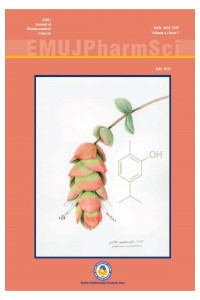ORALLY DISINTEGRATING TABLETS: A SHORT REVIEW
ORALLY DISINTEGRATING TABLETS: A SHORT REVIEW
___
- Abdelbary, G., Eouani, C., Prinderre, P., Joachim, J., Reynier, J. P., & Piccerelle, P. H. (2005).Determination of the in vitro disintegration profile of rapidly disintegrating tablets and correlation with oral disintegration.International journal of pharmaceutics, 292 (1), 29-41.
- Baber, N. (1994). International conference on harmonisation of technical requirements for registration of pharmaceuticals for human use (ICH).British journal of clinical pharmacology, 37(5), 401-404.
- Bhati, R., Nagrajan, R. K. (2012). A detailed review on oral mucosal drug delivery system.International Journal of Pharmaceutical Sciences and Research, 3(3), 659.
- Bi, Y. X., Sunada, H., Yonezawa, Y., & Danjo, K. (1999).Evaluation of rapidly disintegrating tablets prepared by a direct compression method.Drug development and Industrial pharmacy, 25(5), 571-581.
- Bi, Y., Sunada, H., Yonezawa, Y., Danjo, K., Otsuka, A., & IIDA, K. (1996).Preparation and evaluation of a compressed tablet rapidly disintegrating in the oral cavity.Chemical and pharmaceutical bulletin, 44(11), 2121-2127.
- Davtyan, L., Voronkina, A. (2016). International Journal of PharmTech Research. Desai, P. M., Liew, C. V., & Heng, P. W. S. (2016). Review of disintegrants and the disintegration phenomena. Journal of pharmaceutical sciences, 105(9), 2545-2555.
- Handa, U., Saroha, K., & Rana, R. (2016).World Journal of Pharmaceutical and Life Sciences WJPLS.drugs, 1, 2.
- Hannan, P. A., Khan, J. A., Khan, A., & Safiullah, S. (2016). Oral dispersible system: A new approach in drug delivery system. Indian journal of pharmaceutical sciences, 78(1), 2.
- Hooda, R., Tripathi, M., & Kapoor, K. (2012).A review on oral mucosal drug delivery system.The pharma innovation, 1(1).
- Hu, X., Li, Y., Zhang, E., Wang, X., Xing, M., Wang, Q., ...& Huang, H. (2013). Preparation and evaluation of orally disintegrating tablets containing taste-masked microcapsules of berberine hydrochloride.AAPS Pharm.SciTech, 14(1), 29-37.
- Klancke, J. (2003). Dissolution testing of orally disintegrating tablets.Dissolution technologies, 10(2), 6-9. Kraemer, J., Gajendran, J., Guillot, A., Schichtel, J., & Tuereli, A. (2012).Dissolution testing of orally disintegrating tablets.Journal of Pharmacy and Pharmacology, 64(7), 911-918.
- Manivannan, R. (2009). Oral disintegrating tablets: A future compaction. Drug Invention Today, 1(1), 61-65. Mathew, A. K. (2015). Oral local drug delivery: An overview. Pharm. Pharmacol Res, 3, 1-6.
- Mishra, D. N., Bindal, M., Singh, S. K., & Kumar, S. G. V. (2006). Spray dried excipient base: a novel technique for the formulation of orally disintegrating tablets. Chemical and pharmaceutical bulletin, 54(1), 99-102.
- Nagar, P., Singh, K., Chauhan, I., Verma, M., Yasir, M., Khan, A. and Gupta, N. (2011).Orally disintegrating tablets: formulation, preparation techniques and evaluation.
- Rao, K. V., and Venkatachalam, V. V. (2010).Recent Advances in Gastro-Retentive Drug Delivery Systems. Sastry, S. V., Nyshadham, J. R., and Fix, J. A. (2000).Recent technological advances in oral drug delivery–a review.Pharmaceutical science & technology today, 3(4), 138-145.
- Sharma, D. (2013). Formulation development and evaluation of fast disintegrating tablets of salbutamol sulphate for respiratory disorders.ISRN pharmaceutics, 2013.
- Sharma, D., Singh, G., Kumar, D., & Singh, M. (2015). Formulation development and evaluation of fast disintegrating tablets of salbutamol sulphate, cetirizine hydrochloride in combined pharmaceutical dosage form: A new era in novel drug delivery for pediatrics and geriatrics. Journal of drug delivery, 2015.
- Sotoyama, M., Uchida, S., Tanaka, S., Hakamata, A., Odagiri, K., Inui, N.and Namiki, N. (2017). Citric Acid Suppresses the Bitter Taste of Olopatadine Hydrochloride Orally Disintegrating Tablets. Biological and Pharmaceutical Bulletin, 40(4), 451-457.
- Thyssen, A., Remmerie, B., D'Hoore, P., Kushner, S., & Mannaert, E. (2007). Rapidly disintegrating risperidone in subjects with schizophrenia or schizoaffective disorder: a summary of ten phase I clinical trials assessing taste, tablet disintegration time, bioequivalence, and tolerability. Clinical therapeutics, 29 (2), 290-304.
- Velmurugan, S. and Vinushitha, S. (2010). Oral disintegrating tablets: An overview. International Journal of Chemical and Pharmaceutical Sciences, 1(2), 1-12. Zhang, Y., & Carlin, B. (2010).U.S. Patent Application No. 12/702,846.
- ISSN: 2651-3587
- Başlangıç: 2018
- Yayıncı: Doğu Akdeniz Üniversitesi
Sonia SANAJOU, Shalaleh NOURHASHEMİ, Amirhossein FALLAH, Tugba ERCETİN, Mustafa Fethi SAHİN, Hayrettin Ozan GULCAN
ORALLY DISINTEGRATING TABLETS: A SHORT REVIEW
Dilek Emine OZYILMAZ, Leyla Beba POZHARANİ, Mustafa ALHADİ, Adama Emmanuella OCHANYA
REVIEW ON PATIENT SATISFACTION IN PHARMACY SERVICES
Canan GULCAN, Aransiola DAMİLOLA A
PROBIOTICS AND THEIR USES IN CLINICAL PRACTICE – AN OVERVIEW
Mehmet İLKTAÇ, Hanin TANJARA, Sultan ÖĞMEN, Gülden ÇELİK
HONEY PLANTS OF GUZELYURT MORPHOU IN NORTH CYPRUS
Çağın KORKMAZER, F. Neriman ÖZHATAY
EVALUATION OF SPORTS PHARMACY IN TURKEY AND NORTH CYPRUS AS A NEW IMPORTANT FIELD FOR PHARMACISTS
Nimet Ceren ÜRESİN, Somer HELVACI, Gönül ŞAHİN
